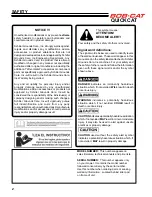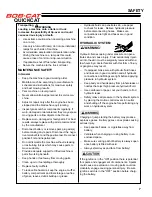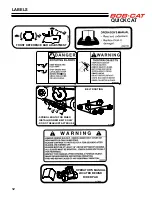
4
QUICKCAT
SAFETY
MACHINE PREPARATION
– Do not tamper with or defeat safety devices.
Keep guards, shields and interlock safety devices
in place and in proper working condition. They
are for your protection.
– Keep all fasteners such as nuts, bolts and pins
well secured.
– Visually inspect blades, blade bolts and the cut-
terdeck assembly for wear or damage. Replace
worn or damaged blades and bolts to preserve
balance.
– Verify that machine and attachments, if any, are
in good operating condition.
– Grass catcher components are subject to wear,
damage and deterioration which could expose
moving parts or allow objects to be thrown.
FUELING
– Gasoline can be extremely flammable; gasoline
vapors are explosive. Use extra care when han-
dling. A fire or explosion from gasoline can burn
you or others and /or cause property damage.
– Fill the fuel tank outdoors on level ground, in an
open area, when the engine is cold and wipe up
any spilled gasoline.
– If the engine has been running, stop the engine
and allow to cool for several minutes.
– Do not smoke, stay away from open flames or
other possible ignition sources.
– Refuel outdoors, do not refuel in indoors or in an
enclosed trailer.
– Use a funnel.
– Do not overfill. Fill to the bottom of the filler neck.
The empty space allows for expansion. Overfill
-
ing may result in fuel leakage or damage to the
engine or emissions system.
– If fuel is spilled, do not attempt to start the engine
until the spill is cleaned up and vapors have
cleared.
– Replace caps on fuel containers and tanks se-
curely.
– Do not operate without the entire exhaust system
in place and in good working condition.
WARNING
Under certain conditions, static electricity can cause
sparks during fueling and start fires or cause explo
-
sions. Flowing fuel can generate static electricity. To
prevent static electricity sparks:
– Keep fuel containers electrically grounded.
–
Do not fill containers in a vehicle or on a truck or
trailer bed with a plastic liner. Fill containers on
the ground away from the vehicle.
– When practical, remove gas powered equip-
ment from the truck or trailer and refuel it on the
ground. If equipment must be refueled on the
truck or trailer, refuel from a portable container
rather than a dispenser nozzle.
– If a dispenser nozzle must be used, keep the
dispenser nozzle in contact with the rim of the
fuel tank or container opening until fueling is
complete. Do not use a nozzle lock-open device
– Replace caps on fuel cans and tanks securely.
– Fill the fuel tank outdoors.
–
Store fuel only in containers specifically de
-
signed for fuel.
Gasoline is harmful or fatal if swallowed. Long-term
exposure to vapors has caused caner in laboratory
animals.
– Avoid prolonged breathing of vapors.
– Keep face away from nozzle and gas tank/con-
tainer opening.
– Keep away from eyes and skin.
– Do not siphon by mouth.
WARNING
WARNING







































